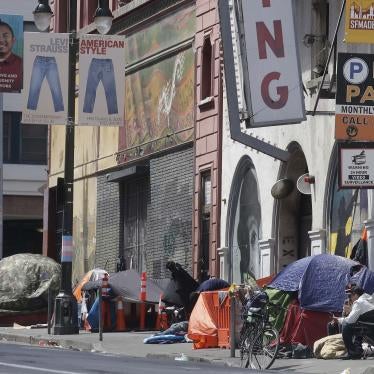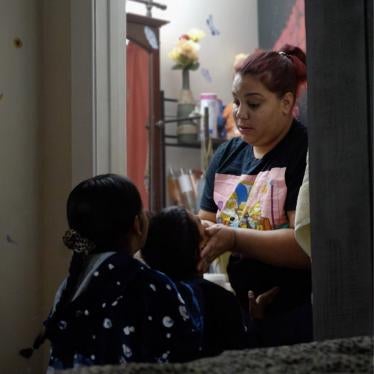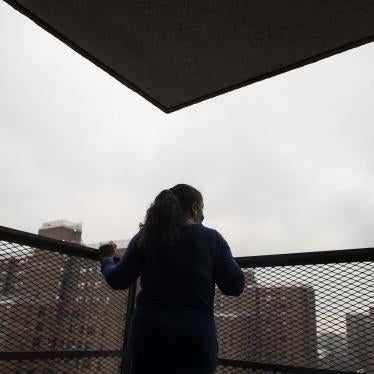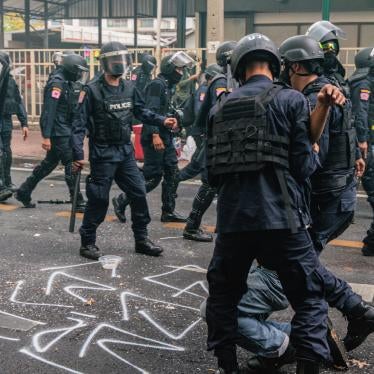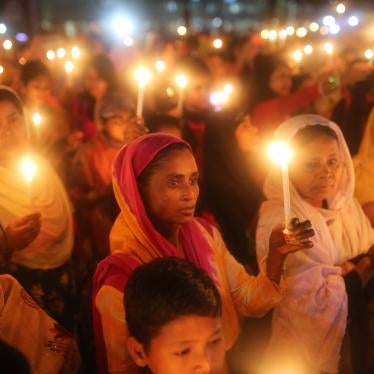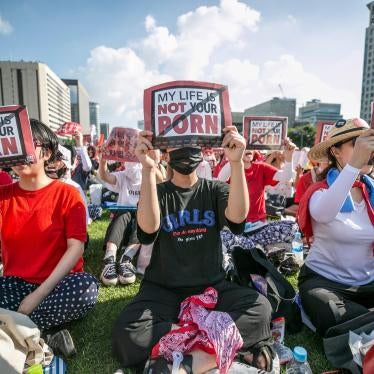January 26, 2023
Judicial Council of California
Probate and Mental Health Advisory Committee
455 Golden Gate Avenue,
San Francisco, California 94102-3688
Submitted via email: invitations@jud.ca.gov
Re: Invitation to Comment W23-10; Rules and Forms: Community Assistance, Recovery, and Empowerment Act
Dear Advisory Committee:
Human Rights Watch has carefully reviewed the eleven rules of court and eleven forms proposed to implement the newly enacted Community Assistance, Recovery, and Empowerment (CARE) Act[1] and writes to respectfully oppose their content and the process and procedures created by them. The CARE Act mandates that the Judicial Council adopt the rules and forms necessary to the CARE court process and the promotion of state-wide consistency.[2] However, the proposed rules and forms fail to remedy the coercion embedded in the system the CARE Act created, that will, in practice, remove unhoused community members with perceived mental health conditions from the public eye without effectively addressing their mental health conditions or lack of housing.[3] Indeed, the rules and forms proposed by the Committee raise new concerns around overbroad application, abuse, and accessibility.
Rather than adopting these proposals and continuing along the path to coercion, we urge you to more deeply consult with disability, racial justice, housing, and peer-led groups to reach a more holistic, rights-respecting approach to address the lack of resources for autonomy-affirming treatment options and affordable housing.
CARE Court is Coerced Treatment.
The proposed rules and forms make clear “to begin CARE Act proceedings, you do not need to provide anyone except the court with a copy of the petition.”[4] Indeed, Rule 7.2235(b) anticipates that a person may learn that they are the subject of a petition, only after a judge has already reviewed their private behavioral health information and set an initial appearance date.[5]
The proposed forms name the expansive categories of petitioners allowed by the CARE Act including: roommates, family members, first responders, police officers, homeless outreach workers, public guardians, conservators, service providers and the director of the county behavioral health agency.[6] These groups have the power to thrust a person into the jurisdiction of the CARE courts without the person’s consent or knowledge, despite the fact that many petitioners may lack any expertise on identifying signs and symptoms of mental health conditions.
The proposed petitioner guidance form (CARE-050-Info) does not remedy this lack of expertise. Rather, it describes respondent eligibility in technical, medical language and lists vague and stereotypical characteristics to cite when claiming someone is experiencing a qualifying mental health condition, such as issues with personal hygiene, difficulty concentrating, and difficulty functioning socially.[7] Even more troubling, the form includes the example of “difficulty maintaining a residence,”[8] which is rooted in structural and societal barriers to housing that may be wholly separate and irrelevant to the manifestation of a mental health condition. Similarly, to support the eligibility requirement that a person be in need of services, the proposed form gives petitioners the example of a person that has access to housing but chooses to live in conditions that could lead to hypothermia.[9] This example wholly ignores the fact that some shelters or other congregate settings may be unsuitable or unacceptable depending on individuals’ circumstances and needs. Also of concern, the form lists an example of a person who has voluntarily accepted treatment that has not been effective in stabilization.[10] If someone has already accepted voluntary treatment, referring them into convoluted, coercive court proceedings that order treatment will do little more than discourage the person from seeking voluntary treatment again in the future.
The broad categories of petitioners not only lack relevant knowledge but raise the specter of abuse. For instance, interpersonal conflicts between family members could result in abusive parents, children, spouses, and siblings vindictively using the referral process to expose their relatives to court hearings and potential coerced treatment, housing, and medication. The proposed form states that the court may determine a person is a vexatious litigant if that person files more than one petition under the CARE Act that has no basis in truth or reality or is aimed at harassment. [11] However, this proviso does not remedy the risk that a vindictive petitioner could abuse the process by initiating a petition just once. A single petition may be enough to derail a person’s life or health.
Nor does this proposal address the possible impact of a threatened petition. Law enforcement and outreach workers may threaten unhoused people with referral to the CARE court process created by the CARE Act to pressure them to move from a given area. Even if these state actors do not then unilaterally funnel those who disobey their commands into the CARE court process, the mere threat of a petition could traumatize and disrupt communities. Given the long history of law enforcement using its authority to drive unhoused people from public spaces, it is dangerous to provide them with additional powers to do so.[12]
In addition to a petition structure unmoored from consent, the proposed rules and forms do not remedy the coercive nature of the contradictory and unworkable CARE court proceedings. CARE-060-INFO, which explains the process to those forced into the jurisdiction of the CARE court,[13] belies any allusions to voluntariness. Through this form a person learns that they are the subject of a petition, the court has appointed them an attorney, and that there will be upcoming meetings and court hearings they are expected to attend.[14] They also learn if they do not attend said hearings, the hearings may continue without them.[15] The related rules on when notice of this information must be provided[16] fail to take into account both the trauma associated with unexpected contact with the legal system and the logistical challenges of providing notice to a person who may be unhoused or housing insecure.
If after a merits hearing on the petition, the court finds the person meets the CARE Act criteria, the person is then required to enter into negotiations with the county behavioral health agency to come up with a purportedly voluntary agreement.[17] However, failure to agree to that supposedly voluntary plan results in a court-ordered clinical evaluation by that same behavioral health agency, which can be used to impose a CARE plan following a hearing on the evaluation and other evidence.[18]
As the proposed forms expound, that CARE plan may include an order to engage in clinical behavioral health care; counseling; specialized psychotherapies, programs, and treatments; stabilization medications; and priority access for certain housing resources.[19] This approach not only robs individuals of dignity and autonomy but is also coercive and likely ineffective.[20] Studies of coercive mental health treatment have generally not shown positive outcomes.[21] Evidence does not support the conclusion that involuntary outpatient treatment is more effective than intensive voluntary outpatient treatment and, indeed, shows that involuntary, coercive treatment is harmful.[22]
Further the housing ordered by the CARE plan may be inadequate. Housing must be provided through a designated list of existing programs that include interim housing or shelter options that may be unacceptable to an individual and unsuited to their unique needs.[23] The CARE Act also does not allow for enforcement of long-term prioritization of housing for its graduates and the graduation plan cannot “place additional requirements on local government entities.”[24]
If a person does not complete the CARE process, the court may “involuntarily reappoint[ ]” them to the program for an additional year.[25] The court may use failure to comply with the CARE plan as “a presumption at that hearing that the respondent needs additional intervention beyond the supports and services provided by the CARE plan.”[26] In practical effect, the mandatory care plans are simply pathways to the even stricter system of control through conservatorship, which may strip a person of their legal capacity and personal autonomy, subjecting them to forcible medical treatment and medication, loss of personal liberty, and removal of power to make decisions over the conduct of their own lives.[27]
This process is entirely coercive, despite procedures that claim to be voluntary. Welfare and Institutions Code section 5801(b)(5), as amended by the CARE Act, makes this coercion clear. It reads: "The client should be fully informed and volunteer for all treatment provided, unless… the client is under a court order for CARE pursuant to Part 8 (commencing with Section 5970) and, prior to the court-ordered CARE plan, the client has been offered an opportunity to enter into a CARE agreement on a voluntary basis and has declined to do so."[28]
Coerced Treatment Violates Human Rights
Under international human rights law, all people have the right to the highest attainable standard of physical and mental health.[29] Free and informed consent, including the right to refuse treatment, is a core element of that right to health.[30] Having a “substitute” decision-maker, including a judge, make orders for health care can deny a person with disabilities their right to legal capacity and infringe on their personal autonomy.[31]
The Convention on the Rights of Persons with Disabilities establishes the obligation to “holistically examine all areas of law to ensure that the right of persons with disabilities to legal capacity is not restricted on an unequal basis with others. Historically, persons with disabilities have been denied their right to legal capacity in many areas in a discriminatory manner under substitute decision-making regimes such as guardianship, conservatorship and mental health laws that permit forced treatment.”[32] The US has signed but not yet ratified this treaty, which means it is obligated to refrain from establishing policies and legislation that will undermine the object and purpose of the treaty.[33] Mandating long-term substitute decision-making schemes like conservatorship or court-ordered treatment plans would defeat the object and purpose of the CRPD, which is to provide persons with disabilities full recognition as rights holders. People’s right to make their own decisions, regardless of the support requirements they might have, instead of being considered as objects of rehabilitation, is a core component of the CRPD.
The World Health Organization has developed a new model that harmonizes mental health services and practices with international human rights law and has criticized practices promoting involuntary mental health treatments as leading to violence and abuse, rather than recovery, which should be the core basis of mental health services.[34] Recovery means different things for different people, but one of its key elements is having control over one´s own mental health treatment, including the possibility of refusing treatment.
To comport with human rights, treatment should be based on the will and preferences of the person concerned. Housing or disability status does not remove a person’s right to legal capacity or personal autonomy. Expansive measures for imposing mental health treatment like the process envisioned by the CARE Act infringe on this right and discriminate on the basis of disability. As discussed above they also run the risk of being abused by self-interested actors. This coerced process for the ostensible aim of treatment undermines any healing aim of the proposal.
CARE Court will Disproportionately Affect BIPOC Communities.
The CARE court program directly targets unhoused people to be placed under court-ordered treatment, thus denying their rights and self-determination. Governor Gavin Newsom, in pitching this plan, called it a response to seeing homeless encampments throughout the state of California.[35] Due to a long history of racial discrimination in housing, employment, access to health care, policing, and the criminal legal system, Black, Indigenous, and People of Color (BIPOC) communities have much higher rates of houselessness than their overall share of the population.[36] The CARE Act in no way addresses the conditions that have led to these high rates of houselessness. Instead, it proposes a system of state control over individuals that will only compound the harms of houselessness.
Further, research shows that due to bias and a lack of cultural competency, mental health professionals over-diagnose and misdiagnose Black and Latino populations at much higher rates than they do white people.[37] One meta-analysis of over 50 separate studies found that Black people are diagnosed with schizophrenia at a rate nearly 2.5 times greater than white people.[38] A 2014 review of empirical literature on the subject found that Black people were diagnosed with psychotic disorders three to four times more frequently, and Latino people approximately three times more frequently, than white people.[39]
CARE Court runs the risk of exacerbating existing racial disparities and may place a disproportionate number of Black, Indigenous, and people of color (BIPOC) individuals under coercive court control. The proposed rules and forms do nothing to remedy this danger.
Conclusion
The CARE Act creates a separate legal track for people perceived to have mental health conditions, without adequate process, negatively affecting the enjoyment of basic rights.[40] The proposed rules and procedures outlined by the Advisory Committee do not ameliorate these objections; instead, they expand the ability of the state to coerce people into treatment and inadequate housing.
Investing in coercive treatment and expanded judicial infrastructure ties up resources that could otherwise be invested in voluntary treatment and the services necessary to make that treatment effective.[41] California should provide well-resourced holistic community-based voluntary options and remove barriers to evidence-based treatment to support people with mental health conditions who might be facing other forms of social exclusion. Such options should be coupled with investment in other social supports, and especially housing, not tied to court supervision.
Sincerely,
Olivia Ensign
Senior Advocate, US Program
Human Rights Watch
John Raphling
Senior Researcher, US Program
Human Rights Watch
[1] “Rules and Forms: Community Assistance, Recovery, and Empowerment Act,” Judicial Council of California invitation to comment, https://www.courts.ca.gov/documents/w23-10.pdf (accessed January 25, 2023).
[2] Ibid., p. 3.
[3] “US: California Should Enact Housing, Treatment Options That Work,” Human Rights Watch news release, September 8, 2022, https://www.hrw.org/news/2022/09/08/us-california-should-enact-housing-treatment-options-work.
[4] “Rules and Forms: Community Assistance, Recovery, and Empowerment Act,” Judicial Council of California invitation to comment, p.25.
[5] Ibid., p. 5.
[6] Ibid., p. 21.
[7] Ibid., p. 22.
[8] Ibid., p. 22.
[9] Ibid., p. 23.
[10] Ibid., p. 23.
[11] Ibid., p. 25.
[12] Chris Herring, “Complaint-Oriented Policing: Regulating Homelessness in Public Space,” American Sociological Review, vol. 84 (2019), pp. 769-80, accessed January 26, 2023, doi:10.1177/0003122419872671.
[13] “Rules and Forms: Community Assistance, Recovery, and Empowerment Act,” Judicial Council of California invitation to comment, p. 26.
[14] Ibid.
[15] Ibid., p. 27.
[16] Ibid., pp. 16-17.
[17] Senate Bill 1338 Community Assistance, Recovery, and Empowerment (CARE) Court Program, 2022, https://leginfo.legislature.ca.gov/faces/billVersionsCompareClient.xhtml?bill_id=202120220SB1338, Section 5977(c).
[18] Ibid., Section 5977.1. (c)(d).
[19] “Rules and Forms: Community Assistance, Recovery, and Empowerment Act,” Judicial Council of California invitation to comment, p. 20; SB 1338, Section 5982(a)
[20] S.P. Sashidharan, Roberto Mezzina, and Dainius Puras. “Reducing Coercion in Mental Healthcare,” Epidemiology and Psychiatric Sciences vol. 28, no. 6 (2019): 605–612, accessed January 26, 2023, doi:10.1017/S2045796019000350. (“Available research does not suggest that coercive intervention in mental health care “are clinically effective, improve patient safety or result in better clinical or social outcomes.”).
[21] Sashidharan, Mezzina, and Puras. “Reducing Coercion in Mental Healthcare,” pp 605-612; Richard M. Ryan, Martin F. Lynch, Maarten Vansteenkiste, and Edward L. Deci, “Motivation and Autonomy in Counseling, Psychotherapy, and Behavior Change: A Look at Theory and Practice,” Invited Integrative Review vol. 39 no.2 (2011): 193–260, accessed January 26, 2023, doi:10.1177/0011000009359313; Paul McLaughlin, Domenico Giacco, and Stefan Priebe, “Use of Coercive Measures during Involuntary Psychiatric Admission and Treatment Outcomes: Data from a Prospective Study across 10 European Countries,” Plods one vol. 11 no. 12 (2016), accessed January 23, 2023, doi:10.1371/journal.pone.0168720. (“All coercive measures are associated with patients staying longer in hospital, and seclusion significantly so, and this association is not fully explained by coerced patients being more unwell at admission.”).
[22] Joseph P. Morrissey, Sarah L Desmarais and Marisa E. Domino, “Outpatient Commitment and Its Alternatives: Questions Yet to Be Answered,” Psychiatric Services vol. 65 no. 6 (2014): 812-814, accessed January 26, 2023, doi:0.1176/appi.ps.201400052; Sashidharan, Mezzina, and Puras. “Reducing Coercion in Mental Healthcare,” 605-612.
[23] SB 1338, Section 5982(a); California Health and Human Services Agency, “CARE (Community Assistance, Recovery and Empowerment) Court,” 2022, https://www.chhs.ca.gov/wp-content/uploads/2022/12/CARE-Act-Overview_ADA-Compliant.pdf (accessed January 26, 2023). The DHHS presentation discusses a range of housing possibilities including “interim or bridge housing,” which in common usage means temporary shelter.
[24] Ibid., Section 5977.3 (a).
[25]Ibid., Section 5977.3 (b)(c).
[27] Ibid., Section 5979(a); California Welfare and Institutions Code, https://leginfo.legislature.ca.gov/faces/codes_displaySection.xhtml?lawCode=WIC§ionNum=5357, Sections 5350—5372.
[28] SB 1338, Section 5801(b)(5).
[29] International Covenant on Economic, Social and Cultural Rights (ICESCR), adopted December 16, 1966, G.A. Res. 2200A (XXI), 21 U.N. GAOR Supp. (No. 16) at 49, U.N. Doc. A/6316 (1966), 993 U.N.T.S. 3, entered into force January 3, 1976, Art. 12(1).
[30] UN Human Rights Council, Report of the Special Rapporteur on the right of everyone to the enjoyment of the highest attainable standard of physical and mental health, A/HRC/35/21, March 28, 2017, https://www.refworld.org/docid/593947e14.html (accessed January 26, 2023), para. 63. See also Convention on the Rights of Persons with Disabilities (CRPD), adopted on December 13, 2006, G.A. Res 61/106, art. 12 & 25, http://www.un.org/disabilities/convention/conventionfull.shtml.; Committee on the Rights of Persons with Disabilities: General comment No. 1, Article 12: Equal recognition before the law, CRPD/C/GC/1 (2014), https://documents-dds-ny.un.org/doc/UNDOC/GEN/G14/031/20/PDF/G1403120.pdf?OpenElement (accessed January 26, 2023), para. 31, 41.
[31] CPRD, art. 12; Convention on the Rights of Persons with Disabilities, art. 12; Committee on the Rights of Persons with Disabilities: General comment No. 1, Article 12: Equal recognition before the law, CRPD/C/GC/1 (2014), https://documents-dds-ny.un.org/doc/UNDOC/GEN/G14/031/20/PDF/G1403120.pdf?OpenElement (accessed January 26, 2023), para. 7.
[32] Ibid.
[33] See Vienna Convention on the Law of Treaties, 1969, art. 18, https://legal.un.org/ilc/texts/instruments/english/conventions/1_1_1969.pdf (accessed January 26, 2023). The Vienna Convention is recognized as customary international law.
[34] World Health Organization and Quality Rights, Freedom from coercion, violence, and abuse, (Geneva: WHO, 2019) 2019, https://apps.who.int/iris/bitstream/handle/10665/329582/9789241516730-eng.pdf?sequence=5&isAllowed=y (accessed January 26, 2023), p. 2, 8, 22.
[35] Marisa Lagos, Gov. Newsom on His New Plan to Tackle Mental Health, Homelessness with ‘CARE Courts’, KQED, March 16, 2022.
[36] Kate Cimini, “Black people disproportionately homeless in California,” CalMatters, February 27, 2021, https://calmatters.org/california-divide/2019/10/black-people-disproportionately-homeless-in-california/ (accessed January 26, 2023). “about 6.5% of Californians identify as black or African American, but they account for nearly 40% of the state’s homeless population”; Esmeralda Bermudez and Ruben Vives, “Surge in Latino homeless population ‘a whole new phenomenon; for Los Angeles,” LA Times, June 18, 2017, https://www.latimes.com/local/california/la-me-latino-homeless-20170618-story.html (accessed January 26, 2023); Los Angeles Homeless Services Authority, Report and Recommendations of the Ad Hoc Committee on Black People Experiencing Homelessness, (Los Angeles: LAHSA, 2018), https://www.lahsa.org/documents?id=2823-report-and-recommendations-of-the-ad-hoc-committee-on-black-people-experiencing-homelessness (accessed January 26, 2023).
[37] Charles M Olbert, Arundati Nagendra, and Benjamin Buck, “Meta-analysis of Black vs. White racial disparity in schizophrenia diagnosis in the United States: Do structured assessments attenuate racial disparities?,” Journal of Abnormal Psychology 127 (2018): 104-115, accessed January 26, 2023, doi: 10.1037/abn0000309; Robert C. Schwartz and David M. Blankenship, “Racial disparities in psychotic disorder diagnosis: A review of empirical literature,” World Journal of Psychiatry 4 (2014): 133-140, accessed January 23, 2023, doi: 10.5498/wjp.v4.i4.133.
[38] Olbert, Nagendra, and Buck, “Meta-analysis of Black vs. White racial disparity in schizophrenia diagnosis in the United States: Do structured assessments attenuate racial disparities?””
[39] Schwartz and Blankenship, “Racial disparities in psychotic disorder diagnosis: A review of empirical literature.”
[40] UN Committee on the Rights of Persons with Disabilities, “Guidelines on article 14 of the Convention on the Rights of Person with Disabilities: The right to liberty and security of persons with disabilities,” September 2015, para. 14.
[41] Physicians for Human Rights, “Neither Justice nor Treatment: Drug Courts in the United States,” June 2017, phr_drugcourts_report_singlepages.pdf (accessed May 5, 2022), p. 3.
